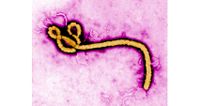Ebola Virus
Ebola, also known as Ebola virus disease (EVD) and Ebola hemorrhagic fever (EHF), is a viral hemorrhagic fever in humans and other primates, caused by ebolaviruses. Symptoms typically start anywhere between two days and three weeks after infection. The first symptoms are usually fever, sore throat, muscle pain, and headaches. These are usually followed by vomiting, diarrhea, rash, and decreased liver and kidney function, at which point some people bleed internally and externally. It kills between 25% and 90% of those infected – about 50% on average. Death is often due to shock from fluid loss, typically between six and 16 days after the first symptoms appear. Early treatment of symptoms increases the survival rate considerably compared to late start. The US FDA approved an Ebola vaccine in December 2019.
The virus spreads through direct contact with body fluids, such as blood from infected humans or other animals, or from contact with items that have recently been contaminated with infected body fluids. There have been no documented cases, either in nature or under laboratory conditions, of spread through the air between humans or other primates. After recovering from Ebola, semen or breast milk may continue to carry the virus for anywhere between several weeks to several months. Fruit bats are believed to be the normal carrier in nature; they can spread the virus without being affected by it. Ebola symptoms may resemble several other diseases, including malaria, cholera, typhoid fever, meningitis and other viral hemorrhagic fevers. Diagnosis is confirmed by testing blood samples for the presence of viral RNA, viral antibodies or the virus itself.
Control of outbreaks requires coordinated medical services and community engagement, including rapid detection, contact tracing of those exposed, quick access to laboratory services, care for those infected, and proper disposal of the dead through cremation or burial. Prevention measures involve wearing proper protective clothing, washing hands when close to patients handling potentially infected bushmeat, and thoroughly cooking bushmeat. The US FDA approved an Ebola vaccine in December 2019. While there is no approved treatment for Ebola as of 2019, two treatments (atoltivimab ↗/maftivimab ↗/odesivimab ↗ and ansuvimab ↗) are associated with improved outcomes. Supportive efforts also improve outcomes. These include oral rehydration therapy (drinking slightly sweetened and salty water) or giving intravenous fluids, and treating symptoms. In October 2020, atoltivimab/maftivimab/odesivimab (Inmazeb) was approved for medical use in the United States to treat the disease caused by Zaire ebolavirus.
Reston virus (RESTV)
Reston virus (RESTV) is one of six known viruses within the genus Ebolavirus. Reston virus causes Ebola virus disease in non-human primates; unlike the other five ebolaviruses, it is not known to cause disease in humans, but has caused asymptomatic infections. Reston virus was first described in 1990 as a new "strain" of Ebola virus (EBOV). It is the single member of the species Reston ebolavirus, which is included into the genus Ebolavirus, family Filoviridae, order Mononegavirales. Reston virus is named after Reston, Virginia, US, where the virus was first discovered.
RESTV was discovered in crab-eating macaques from Hazleton Laboratories (now Labcorp Drug Development) in 1989. This attracted significant media attention due to Reston's location in the Washington, DC metro area and the lethality of a closely related Ebola virus. Despite its status as a level-4 organism, Reston virus is non-pathogenic to humans, though hazardous to monkeys; the perception of its lethality was compounded by the monkey's coinfection with Simian hemorrhagic fever virus (SHFV). Despite ongoing research, the determinants for lack of human pathogenicity are yet to be discovered.
See also [ Hot Zone ]
Why is this article included on the SM-201 site?
- Much of the earliest research and identification of these two diseases were done using Durrum D-500 Amino-acid analyzers.
From Robin's resume
- Durrum Instruments 1972 to 1974
- As the Director of Field Service Engineering, I affected the installation of Durrum D-500 Amino-acid Analysis Equipment in the US and abroad; performed on-site service & preventative maintenance; taught medical and research personnel how to prepare hemo-urological samples for analysis in hospital and research laboratory environments; taught classes on use and maintenance of the equipment. I worked with design engineers to improve speed and performance. As an outcome of my work at Durrum, the company received multiple patents and the Nobel Peace Prize for Medical Research in RNA/DNA genetic research and engineering.
- More information is available at [ Wikipedia:Ebola_Virus ]
Chat rooms • What links here • Copyright info • Contact information • Category:Root
